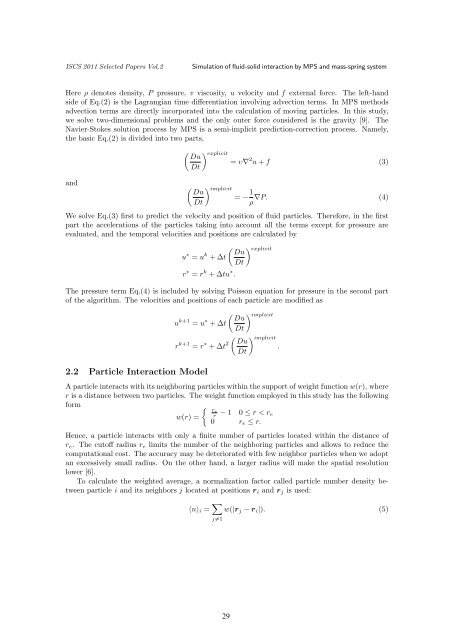RECENT DEVELOPMENT IN COMPUTATIONAL SCIENCE
RECENT DEVELOPMENT IN COMPUTATIONAL SCIENCE
RECENT DEVELOPMENT IN COMPUTATIONAL SCIENCE
You also want an ePaper? Increase the reach of your titles
YUMPU automatically turns print PDFs into web optimized ePapers that Google loves.
ISCS 2011 Selected Papers Vol.2 Simulation of fluid-solid interaction by MPS and mass-spring system<br />
Here ρ denotes density, P pressure, v viscosity, u velocity and f external force. The left-hand<br />
side of Eq.(2) is the Lagrangian time differentiation involving advection terms. In MPS methods<br />
advection terms are directly incorporated into the calculation of moving particles. In this study,<br />
we solve two-dimensional problems and the only outer force considered is the gravity [9]. The<br />
Navier-Stokes solution process by MPS is a semi-implicit prediction-correction process. Namely,<br />
the basic Eq.(2) is divided into two parts,<br />
and<br />
( ) explicit<br />
Du<br />
= υ∇<br />
Dt<br />
2 u + f (3)<br />
( ) implicit<br />
Du<br />
Dt<br />
= − 1<br />
∇P. (4)<br />
ρ<br />
We solve Eq.(3) first to predict the velocity and position of fluid particles. Therefore, in the first<br />
part the accelerations of the particles taking into account all the terms except for pressure are<br />
evaluated, and the temporal velocities and positions are calculated by<br />
u ∗ = u k + ∆t<br />
r ∗ = r k + ∆tu ∗ .<br />
( ) explicit<br />
Du<br />
Dt<br />
The pressure term Eq.(4) is included by solving Poisson equation for pressure in the second part<br />
of the algorithm. The velocities and positions of each particle are modified as<br />
u k+1 = u ∗ + ∆t<br />
r k+1 = r ∗ + ∆t 2<br />
2.2 Particle Interaction Model<br />
( ) implicit<br />
Du<br />
Dt<br />
( ) implicit<br />
Du<br />
.<br />
Dt<br />
A particle interacts with its neighboring particles within the support of weight function w(r), where<br />
r is a distance between two particles. The weight function employed in this study has the following<br />
form<br />
{ re<br />
w(r) = r − 1 0 ≤ r < re<br />
0 re ≤ r.<br />
Hence, a particle interacts with only a finite number of particles located within the distance of<br />
re. The cutoff radius re limits the number of the neighboring particles and allows to reduce the<br />
computational cost. The accuracy may be deteriorated with few neighbor particles when we adopt<br />
an excessively small radius. On the other hand, a larger radius will make the spatial resolution<br />
lower [6].<br />
To calculate the weighted average, a normalization factor called particle number density between<br />
particle i and its neighbors j located at positions ri and rj is used:<br />
〈n〉i = ∑<br />
w(|rj − ri|). (5)<br />
j�=1<br />
29


